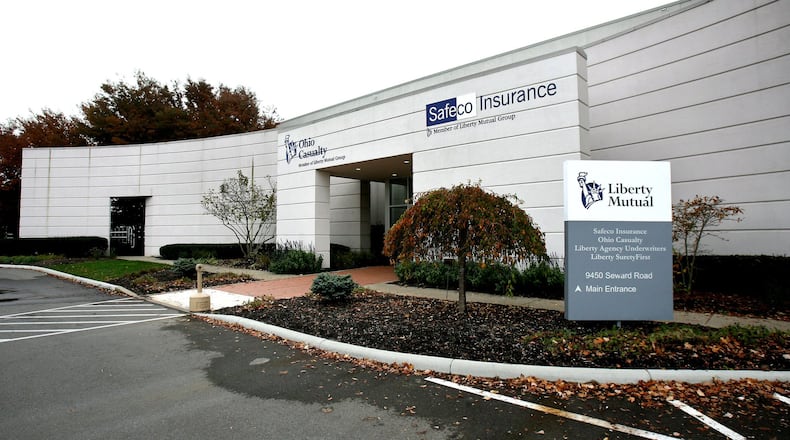The paper and steel industries were king in the county in years past, but that’s not the case today, which is a good thing according to Development Director David Fehr.
“Economically it’s better to have some diversity. We are fairly diversified, we don’t have one employer that has half the employees in the county...,” Fehr said. “If you look at this list if one of these places closed up shop, yeah we would feel it but it’s not catastrophic.”
The most recent Butler County Comprehensive Annual Financial Report from 2019 estimated the total income earned by Butler County employees was $18.1 billion. Earnings are crucial to local governments because cities rely mainly on income taxes to provide services like roads, utilities and other functions.
The county is losing its eighth largest employer this year, as Liberty Mutual is in the process of leaving Fairfield and relocating to neighboring Forest Park. The insurance giant once had 1,400 employees, but spokesman Glenn Greenberg told the Journal-News earlier this year the company had 800 employees at the Seward Road site and 300 who work remotely.
“This is a way for us to decrease costs and improve competitiveness by reducing our unused space and maintaining what we need,” he said.
Fairfield Assistant Manager Scott Timmer said officials thought something was going on with the company in late 2018 or early 2019 when income tax revenues started dropping. In 2011, revenues to the city were $1.16 million, and they dropped to $544,145 last year. The city collected a total of $32.8 million in earnings taxes last year.
“We’ve been able to diversify enough where we were able to take the hit and not be, I guess, overly wounded by it,” Timmer said about the departure. “Granted we would absolutely have loved it if they’d stayed and stayed at the $1 million number, but some things are out of our control.”
Liberty Mutual sold its property on Seward Road. The site, now known as the Fairfield Commerce Park, is anticipated to attract 600 to 1,000 jobs as it constructs new buildings on the 137 acres. It is designed to attract the e-commerce and light industrial industries.
Timmer said the city won’t know the full impact on income tax revenue until new tenants are occupying the development.
On the positive side, Fairfield’s Cincinnati Financial Corp, which is the county’s second-largest employer with 3,234 people, deposited $4.7 million in earnings tax into the city’s coffers last year compared to $2.6 million in 2011.
Cities across the county might take a hit to income tax revenues due to work-from-home changes during the coronavirus pandemic. The state approved emergency legislation last year that employees working remotely would still pay income taxes to the community where their employer is located.
The order has expired, but there is pending legislation that would allow workers to get refunds from 2020 and 2021, according to Oxford City Manager Doug Elliott.
“If this provision becomes law, the city will be obligated to refund money received in fiscal year 2020 and fiscal year 2021,” Elliott said. “I have estimated the city of Oxford’s loss in income tax revenue at $1.5 million. This represents 16.7% of estimated fiscal year 2021 income tax revenue.”
Trenton Finance Director Mike Engle said other pandemic provisions have also delayed income tax collections because deadlines for paying taxes were extended. He said the “rule of law” in municipal income tax has always made the physical location of an employer the priority taxing location. The potential refund would have a huge impact.
“The huge increase in working from home has caused mayhem between that traditional rule of law versus the new pandemic work reality,” Engle said.
The pandemic also has officials wondering if companies will start relocating because the remote working operation has now been tested, according to Tom Vanderhorst, Hamilton’s executive director of external services.
“The pandemic forced people to work from home and the science project lasted long enough employers can see whether it was really effective or not,” Vanderhorst said. “This is a nationwide trend it’s not just southwest Ohio, especially in some of the bigger cities you see investment bankers migrating from New York City and going to Miami because the climate’s better, it’s cheaper to live there and you can work remote.”
Some of the largest employers —seven of them —are the governments themselves and school districts on the list of 34 largest employers, which can’t relocate. Butler County employs 2,044 people and is Hamilton’s top employer and fifth-highest in the county. Lakota Schools are sixth but located in Liberty and West Chester townships, where collecting income taxes aren’t collected.
The four hospitals and 11 manufacturing companies also could not effectively work remotely. Vanderhorst said Hamilton has a host of diverse new companies coming, so he isn’t strongly concerned about a post-pandemic exodus.
“Our economic development team has just really done a great job luring businesses here because the town is just really getting a cool vibe to it,” Vanderhorst said. “We have land that we can offer, we have workforce that we can put on the ground for them, we own our own utilities. I think we’re going to be fine.”
Income tax is not the only benefit of having a good crop of big businesses, Fehr said the bigger companies also have very philanthropic and volunteering cultures.
“Generally the bigger companies are a bit more engaged in the community because they can afford to be...,” Fehr said. “Having larger companies they can be a bit more philanthropic and allow some of their employees to be engaged on boards and committees and things like that, that you need. That is a benefit of some of these larger corporations.”
About the Author

